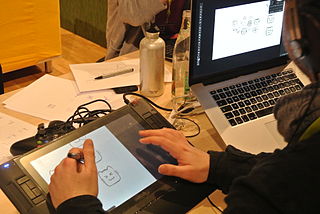Related Research Articles

Computer animation is the process used for digitally generating animations. The more general term computer-generated imagery (CGI) encompasses both static scenes and dynamic images, while computer animation only refers to moving images. Modern computer animation usually uses 3D computer graphics to generate a three-dimensional picture. The target of the animation is sometimes the computer itself, while other times it is film.
In animation and filmmaking, a key frame is a drawing or shot that defines the starting and ending points of a smooth transition. These are called frames because their position in time is measured in frames on a strip of film or on a digital video editing timeline. A sequence of key frames defines which movement the viewer will see, whereas the position of the key frames on the film, video, or animation defines the timing of the movement. Because only two or three key frames over the span of a second do not create the illusion of movement, the remaining frames are filled with "inbetweens".
Adobe Photoshop is a raster graphics editor developed and published by Adobe Inc. for Windows and macOS. It was originally created in 1987 by Thomas and John Knoll. Since then, the software has become the most used tool for professional digital art, especially in raster graphics editing. The software's name is often colloquially used as a verb although Adobe discourages such use.
Frame rate is typically the frequency (rate) at which consecutive images (frames) are captured or displayed. This definition applies to film and video cameras, computer animation, and motion capture systems. In these contexts, frame rate may be used interchangeably with frame frequency and refresh rate, which are expressed in hertz. Additionally, in the context of computer graphics performance, FPS is the rate at which a system, particularly a GPU, is able to generate frames, and refresh rate is the frequency at which a display shows completed frames. In electronic camera specifications frame rate refers to the maximum possible rate frames could be captured, but in practice, other settings may reduce the actual frequency to a lower number than the frame rate.

Morphing is a special effect in motion pictures and animations that changes one image or shape into another through a seamless transition. Traditionally such a depiction would be achieved through dissolving techniques on film. Since the early 1990s, this has been replaced by computer software to create more realistic transitions. A similar method is applied to audio recordings, for example, by changing voices or vocal lines.

A storyboard is a graphic organizer that consists of illustrations or images displayed in sequence for the purpose of pre-visualizing a motion picture, animation, motion graphic or interactive media sequence. The storyboarding process, in the form it is known today, was developed at Walt Disney Productions during the early 1930s, after several years of similar processes being in use at Walt Disney and other animation studios.

Onion skinning, in 2D computer graphics, is a technique used in creating animated cartoons and editing movies to see several frames at once. This way, the animator or editor can make decisions on how to create or change an image based on the previous image in the sequence.

Traditional animation is an animation technique in which each frame is drawn by hand. The technique was the dominant form of animation in cinema until the end of the 20th century, when there was a shift to computer animation in the industry, specifically 3D computer animation.

Digital painting is an established art medium that typically combines a computer, a graphics tablet, and software of choice. The artist uses painting and drawing with the stylus that comes with the graphics tablet to create 2D paintings within a digital art software. Digital artists utilize multiple techniques and tools, the main one being digital brushes. These come standard with all digital art programs, but users can create their own by altering their shape, texture, size, and transfer. Many of these brushes are created to represent traditional styles like oils, acrylics, pastels, charcoal, and airbrushing, but not all. Other effective tools include layers, lasso tools, shapes, and masks. Digital painting has evolved to not just mimic traditional art styles but fully become its technique.

Digital illustration or computer illustration is the use of digital tools to produce images under the direct manipulation of the artist, usually through a pointing device such as a graphics tablet or, less commonly, a mouse. It is distinguished from computer-generated art, which is produced by a computer using mathematical models created by the artist. It is also distinct from digital manipulation of photographs, in that it is an original construction "from scratch". Photographic elements such as background or texture may be incorporated into such works, but they are not necessarily the primary basis.
In visual effects, match moving is a technique that allows the insertion of computer graphics into live-action footage with correct position, scale, orientation, and motion relative to the photographed objects in the shot. The term is used loosely to describe several different methods of extracting camera motion information from a motion picture. Sometimes referred to as motion tracking or camera solving, match moving is related to rotoscoping and photogrammetry. Match moving is sometimes confused with motion capture, which records the motion of objects, often human actors, rather than the camera. Typically, motion capture requires special cameras and sensors and a controlled environment. Match moving is also distinct from motion control photography, which uses mechanical hardware to execute multiple identical camera moves. Match moving, by contrast, is typically a software-based technology, applied after the fact to normal footage recorded in uncontrolled environments with an ordinary camera.

Adobe Flash animation is an animation that is created with the Adobe Animate platform or similar animation software and often distributed in the SWF file format. The term Adobe Flash animation refers to both the file format and the medium in which the animation is produced. Adobe Flash animation has enjoyed mainstream popularity since the mid-2000s, with many Adobe Flash-animated television series, television commercials, and award-winning online shorts being produced since then.
In computer graphics, graphics software refers to a program or collection of programs that enable a person to manipulate images or models visually on a computer.
In computer graphics, image tracing, raster-to-vector conversion or raster vectorization is the conversion of raster graphics into vector graphics.

Motion graphics are pieces of animation or digital footage which create the illusion of motion or rotation, and are usually combined with audio for use in multimedia projects. Motion graphics are usually displayed via electronic media technology, but may also be displayed via manual powered technology. The term distinguishes static graphics from those with a transforming appearance over time, without over-specifying the form. While any form of experimental or abstract animation can be called motion graphics, the term typically more explicitly refers to the commercial application of animation and effects to video, film, TV, and interactive applications.
A storyboard artist creates storyboards for advertising agencies and film productions.
Bob Sabiston is an American film art director, computer programmer, and creator of the Rotoshop software program for computer animation. Sabiston began developing software as an undergraduate and then graduate researcher in the MIT Media Lab from 1986 to 1991. While at MIT, and also after moving to Austin, Texas, in 1993, Sabiston used his 2D/3D software to create several short films, including God's Little Monkey (1994), "Beat Dedication" (1988), and "Grinning Evil Death" (1990). "Grinning Evil Death" was widely seen on the first episode of MTV's "Liquid Television" show. "God's Little Monkey" won the Prix Ars Electronica Golden Nica award for 1994.

DrawPlus is a 2D vector graphics editor and animation software developed by the UK-based software company Serif, also responsible for PhotoPlus, PagePlus, WebPlus, Digital Scrapbook Artist, Affinity Designer, Affinity Photo and other titles.

3D computer graphics, sometimes called CGI, 3D-CGI or three-dimensional computer graphics are graphics that use a three-dimensional representation of geometric data that is stored in the computer for the purposes of performing calculations and rendering digital images, usually 2D images but sometimes 3D images. The resulting images may be stored for viewing later or displayed in real time.

Boxy SVG is a vector graphics editor for creating illustrations, as well as logos, icons, and other elements of graphic design. It is primarily focused on editing drawings in the SVG file format. The program is available as both a web app and a desktop application for Windows, macOS, ChromeOS, and Linux-based operating systems.
References
- ↑ Los Angeles Times
- ↑ Stevenson, Seth (2005-12-05). "Money Toons: The distinctive animated ads from Charles Schwab". Slate . Retrieved 2016-07-06.
- ↑ Flat Black Films